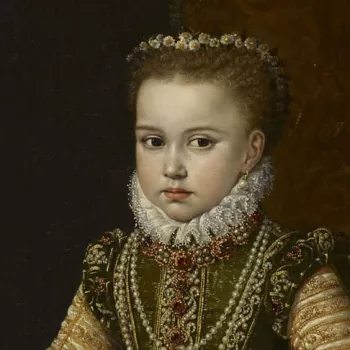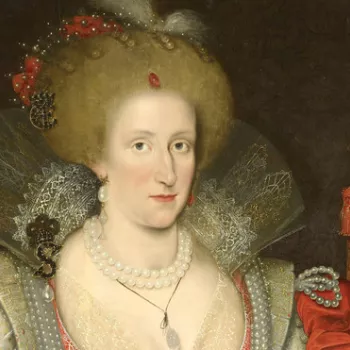Margaret of Austria, Queen Consort of Philip III of Spain (1584-1611) c.1605
Oil on canvas | 204.6 x 121.2 cm (support, canvas/panel/stretcher external) | RCIN 404970
-
Juan Pantoja de La Cruz was the foremost Spanish portrait painter of the late sixteenth and early seventeenth century and was court painter to both Phillip II and Phillip III of Spain. This bold painting follows in the tradition of Spanish royal portraits and was designed to convey an image of courtly majesty. Juan Pantoja de La Cruz received his training in the Madrid workshop of court painter Alonso Sánchez Coello (1532-1588), whose work is also represented in the Royal Collection (see RCINs 405798, 404331). Here he learned the traditions of Spanish royal portraiture. The sixteenth century Spanish School had been stimulated by Italian influences; in particular by Titian and his work for the Spanish court (c. 1548 - 1570). A follower of Titian, Sánchez Coello had pioneered the Spanish manner of portraiture with the additional influence of his Netherlandish master Anthonis Mor van Dashorst (see RCINs 405799). Pantoja is known to have collaborated to a significant extent on many of his master's mature works and there are a number of anonymous paintings from the workshop which are likely by him. There are relatively few signed works by Pantoja prior to the death of Sánchez Coello in 1588, though he was by then an independent artist. Pantoja did not take his master's place as an official court painter until the accession of Philip III in 1598; however, a number of royal portraits including one of Don Philip, the future Philip III (Kunsthistorisches, Vienna) survive from as early as 1590. Concerned more with the portrayal of solemn and imposing majesty than with reproducing an individual likeness, Pantoja's style of portraiture perpetuated that of Sánchez Coello, reflecting the influences of both the Venetian and Flemish traditions. His portraits are characterized by a precise handling of elaborate textures and a Netherlandish precision in the rendering of detail, particularly as regards the ornate attire and jewels worn by the court. However, in his treatment of faces he clearly references the Venetian school, in particular Titian, whose famous portrait of Charles V (Alte Pinakothek, Munich) he is known to have copied. Portraits of Spanish Habsburg Queens were designed to be complementary to those of Kings and have a distinct iconography. Depicted formally without humor or seductive charm, portraits of Habsburg Queens traditionally subordinate the individual to the body politic responsible for sustaining the legitimacy and succession of the dynasty. Pantoja's portrait of Margaret of Austria, given as a gift to James I in 1605 following the peace treaty between England and Spain, follows in these traditions, though the ideology of Spanish Habsburg rule is more blatant than in earlier royal portraits. The Queen's full-length figure dominates the space, her ornate dress, known as a saya is emblazoned with the coats of arms of Castile-Leon and Austria, as well as sprays of flowers, monograms and pearls. She wears the spectacular 'joyel rico', a square table-cut diamond she was said to have worn at the signing of the London Treaty. From it hangs the famous La Peregrina pearl given to Mary I of England by Phillip II as an engagement gift but returned to the Spanish crown on her death. Pantoja shows the Queen holding a Book of Hours; she gazes directly at the viewer while holding open the book to show an illumination of the Woman of the Apocalypse. During this period the Woman of the Apocalypse symbolized the Immaculate Conception. By prominently displaying the illuminated page, Pantoja's portrait demonstrates the Queen's commitment not only to her Catholic faith but to the cult of the Immaculate Conception of the Blessed Virgin, which had been rejected by the Protestant religion. Margaret of Austria is known to have written letters to Rome to promote papal definition of the Immaculate Conception and some have suggested that this is represented by the letter visible in the lower left corner of the work.
Provenance
Given to James I by Phillip III of Spain; sold as a pair for £15 to Robert Houghton and others on 23 October 1651 (no 332); recovered at the Restoration and listed in the 2nd Privy Lodging Room at Whitehall in 1666 (no 216)
-
Creator(s)
Acquirer(s)
-
Medium and techniques
Oil on canvas
Measurements
204.6 x 121.2 cm (support, canvas/panel/stretcher external)
220.6 x 137.0 x 7.4 cm (frame, external, + buildup)
Category
Object type(s)
Alternative title(s)
Elizabeth of Valois, Queen consort of Philip II (previously identified as)











